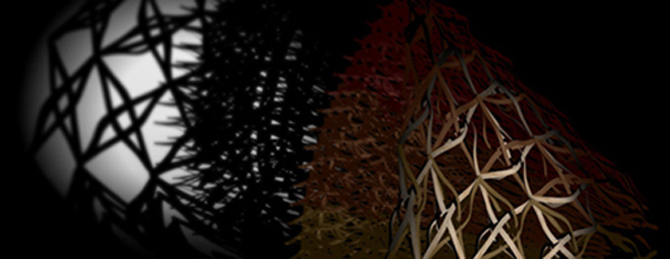Transmaterial Aesthetics: Experiments with Timber in Architecture and Technology
1 - 2 October 2013
International Conference by HS Wismar and UTS Sydney

BACKGROUND
In the light of increasing environmental awareness, timber emerged at the forefront of material investigations in architecture over the past decades. Waste material from the end of the manufacturing process, or recycled material is fused with other materials to produce composites with changed structural, performative and aesthetic properties. Pulped, cast, bundled, 3D-printed, and robotically-stacked, new technologies enabled a radical shift away from traditional tectonics and towards articulations previously associated with other materials such as concrete, masonry and plastics. Together, these experiments give rise to a new techno-aesthetic paradigm that could be described as a form of transmateriality.
In nineteenth century architectural theory, Gottfried Semper’s Practical Aesthetics already suggested a synthesis between artistic and technological developments brought about by processes of material transfiguration (Stoffwechsel). Today, new visual languages emerge alongside innovative technologies that permit the realistic study of material changes across structures: in folded plates, grid-shells and multi-reciprocal frames, structural integrity is achieved through grading, layering and fusing of surfaces. In practice, developments in timber range from Walter Gropius’s and Konrad Wachsmann’s Packaged House, which unsuccessfully attempted to sell the modern dream of technologically advanced living to the masses, to Jürgen Mayer H’s Metropol Parasol whose captivating elastic forms promise the activation of public space.
PROGRAMME
DAY ONE: TUESDAY OCTOBER 1 2013
INTRODUCTORY LECTURE
Transmaterial Aesthetics
Sandra Karina Löschke, University of Technology Sydney
SESSION 1 – ‘WOODNESS’
Moderation: Sandra Karina Löschke
Wood unscripted potentials. How can material deficiencies become strengths
Marcin Wójcik, Oslo School of Architecture and Design, Norway
Covering Artschwager: An Encomium on Woodness and the “Perceptual, Real, and Faux”
Margarita McGrath, Virginia Tech, U.S.A.
The antifragility of vegetal life and the provenance of timber in design
Gregory Nolan, Jon Shanks, Stephen Loo, University of Tasmania, Australia
Minimalist materiality in wood: Working with wood as a natural material
Patrick Fleming, Michael Ramage, Cambridge University, UK
KEYNOTE 1
Rethinking timber - Research and advanced engineering for Metropol Parasol
Professor Volker Schmid, TU Berlin / Arup Berlin, Germany
KEYNOTE 2
Digital Production
Arnold Walz, designtoproduction, Stuttgart/Zürich, Germany/Switzerland
DAY TWO: WEDNESDAY OCTOBER 2 2013
SESSION 2 – TECHNOLOGY + AESTHETICS
Moderation: Matthias Ludwig
The re-emergence of the designer-maker in the new techno-aesthetic paradigm
Jon Shanks, Peter Booth, Greg Nolan, Robin Green, Roberto Davolio, University of Tasmania, Australia and AWAWA1
Bended - Material- and process-informed Design Computation
Hans Sachs, CIAD, Cologne Institute for Architectural Design, Germany
The Project Reframed: Instigating change through light-weight timber structures
Luis Feduchi, University of Queensland, Australia
SESSION 3 – PROCESS
Moderation: Stephen Loo
Timberfabric - Applying Textile Assembly Principles for Wood Construction in Architecture
Markus Hudert, Swiss Federal Institute of Technology Lausanne, Switzerland
Emergent timber: A tool for designing the growth process of Baubotanik structures
Ferdinand Ludwig, Boyan Mihaylov and Tobias Schwinn, Research Group Baubotanik, Institute for Theory of Modern Architecture in collaboration with Institute for Computational Design, University of Stuttgart, Germany
Structural analysis and optimisation of a computationally designed Plywood Gridshell
Gregory Quinn and Christoph Gengnagel, Universitat der Künste Berlin, Germany
SESSION 4 - EXPERIMENT AND FABRICATION
Moderation: Luis Feduchi
Applying the Borrowed_ Learning through Making (invited)
Clara Kraft Isono and Satoshi Isono, University of East London, UK
Ply Project
Kenichi Sato and Rodney Hayward, Architect, Berlin/Tokyo and Australian National University, Australia
3F-board (invited)
Achim Hack, Frank Ackermann, Hochschule Wismar, Germany and Ackermann GmbH, Germany
Prefabricated Housing in Australia, Past and Future (invited)
Mathew Aitchison, University of Queensland, Australia
PLENUM SESSION
KEYNOTE 3
Mobiversum
Christoph Emenlauer/Jürgen Mayer H., Germany
KEYNOTE 4
Vertical Timber Construction
Kaden Klingbeil Architects, Germany

